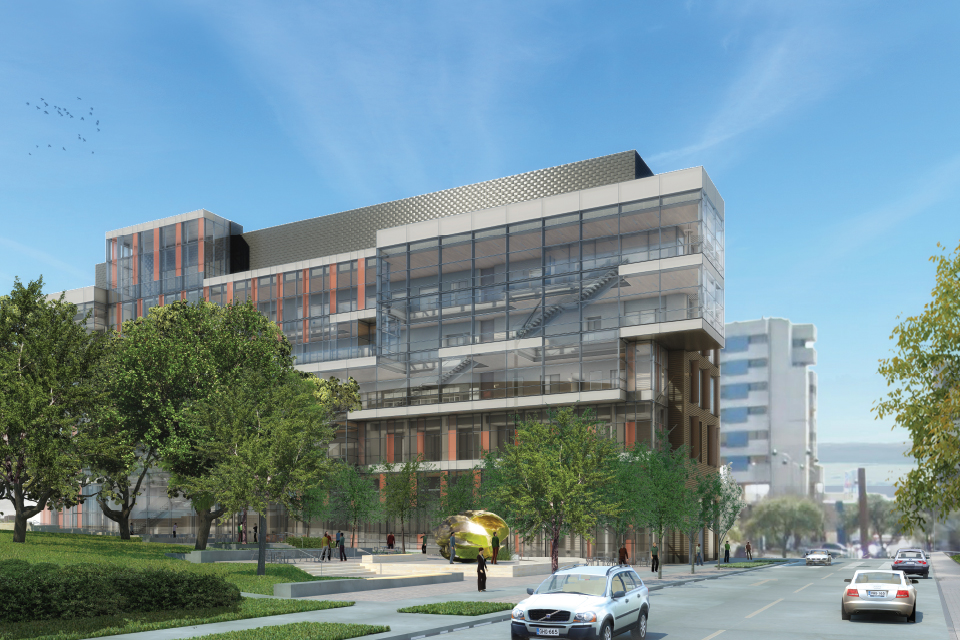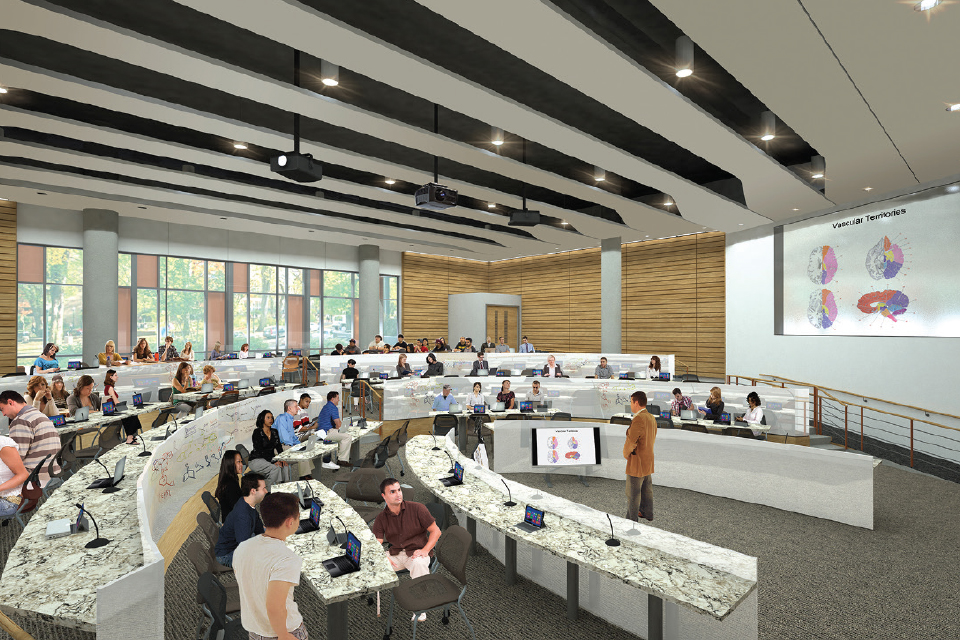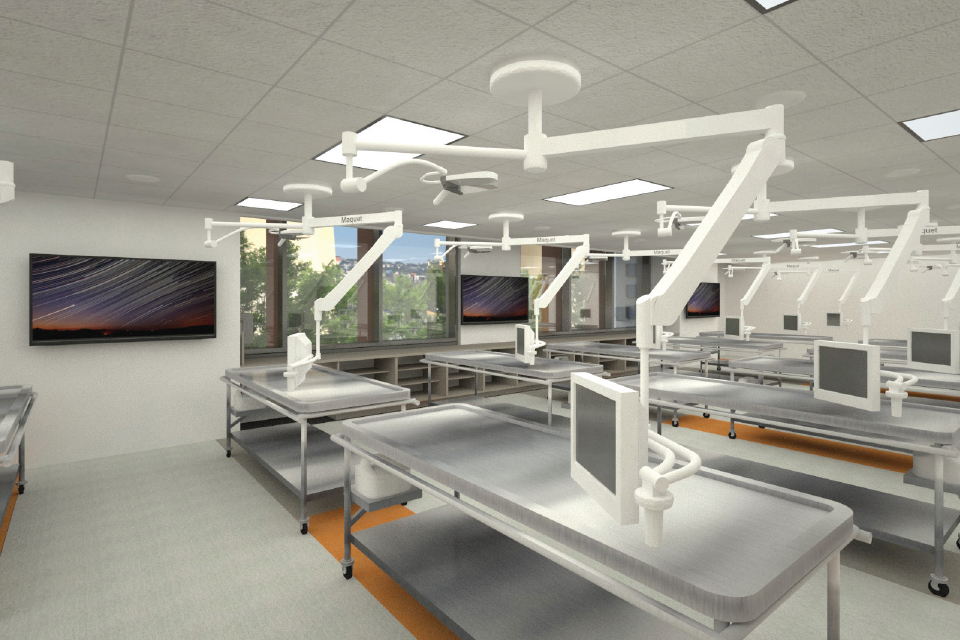Dell Medical School Innovation in Healthcare Education

Assuming a role in the world of healthcare is a massive undertaking. Practicing physicians with a commitment to fulfill the Hippocratic Oath, elected officials striving to make it more accessible and affordable, biomedical engineers working on new prosthetics, and everyone in between have a place in medical treatment. But it’s not as segmented as it seems. If everyone worked on their respective projects independently, that still wouldn’t simplify the system. The current state of the healthcare system bears a comparison to a tangled ball of Christmas lights. Once unstrung, it’s bright and awe-inspiring, but as a giant knot it’s overwhelming and in need of a strategic course of action.
The University of Texas at Austin’s Dell Medical School is taking on that challenge–and they’re doing it enthusiastically. Our city harbors thousands of academics, but Dell Medical School wants to attract a new breed of scholars and leaders to strengthen its foundation. Change starts from the ground up, which is why its implementing new practices and rallying for change through the medical school classes. Rather than solely focusing on its students, though, Dell Medical School is looking at the big picture.
“It behooves us to step back at every point and ask, ‘Why are we doing things this way? Is it because academic medicine has been doing it this way all along or is it because it’s the best way to do it?’” said Dr. Mini Kahlon, Vice Dean of Strategy and Partnerships. Kahlon wants Dell Medical School to be a pioneer for change, so she recruited a couple of people who understand it best: entrepreneurs.
“In my opinion, to do things differently, you need to bring in someone who thinks differently,” Kahlon said. Austin’s booming startup scene is bursting with creativity, so Kahlon didn’t have to look far for consultants. Among them is entrepreneurial standout Mellie Price, who accepted a position as Executive Director of Technology. If her name rings familiar, you may recognize it from her previous stint as founder of Front Gate Solutions—a locally-based ticketing powerhouse. Having someone like Price advising the curriculum will prepare students to enter the constantly changing field, and also train them to be in the mindset of continually thinking anew.
“When I think about innovation and the things we do—yes, we hope to see 3D printing and tools and technology. But the core innovation is the move from healthcare to health,” Kahlon said.
Keep reading!

Kahlon embraces this new opportunity to recreate a better system. So many modifications are taking place, it’s nearly become an existential reformation. It begins with heavy questions: What is the responsibility of a healthcare provider? What is the purpose of healthcare?
Consider what it means to be a patient. You are a patient when you’re receiving medical treatment. The kind of physician Dell Medical School wants to create will care for you as a person, not just as a patient. Your life happens outside of a clinic, and your health is influenced by the way you live it.
“A parent is much more a physician than a physician is. The neighborhood is critical. All of these become important factors—when we think about reinventing care and health, we’re stepping back and looking at where health is being played out,” Kahlon said.
This is evident even in our city’s infrastructure. The number of well-designed bike lanes pull more cyclists to the streets. The centrally-located body of water we have access to encourages residents to kayak or stand-up paddleboard. The trail around Lady Bird Lake (in addition to the vast network of pathways running through the greenbelt and around the city) draws walkers and runners outside to be active. “The trail is just as much of an asset as a clinic. More people interact with the trail. We want them to spend more time there than in a clinic!” Kahlon said.
Creating this kind of reach from a medical school requires a convening of influential partners and stakeholders. Referred to as “population health,” Dell Medical School is stressing such an importance on community initiatives that they’ve brought on Dr. William Tierney to serve as the inaugural Chair of Population Health. His previous work experience highlighted a few potential solutions to the healthcare system.
“We took people with prediabetes, and randomized them into two different groups. The first group received regular care, while the second group received regular care plus a free pass to the YMCA. The group with the gym membership had half the occurrence of diabetes,” Tierney said.
To provide extra perspective, he compares the cost. A monthly membership for one adult runs at $45—far less expensive than a lifetime of treating diabetes. Presently, medical bills are the No. 1 cause of bankruptcy in this country, so finding affordable approaches to healthcare is high on the list of priorities for Tierney. After all, that’s just part of population health.
Population health has an ever-changing definition—it’s dependent on who you accept responsibility for. Regular practicing physicians have a “population” made up of all the people in their caseload. For Dell Medical School, the “population” being addressed is Travis County.
“They wanted UT to have a medical school, and we made it our mission to extend beyond that—making Travis County healthier. We care about the patients who aren’t coming in, because either they aren’t sick yet or they don’t have access,” Tierney said.
To reiterate Kahlon’s point, our city’s health management takes place practically everywhere outside of a clinic. It’s how we maintain our health and stay educated on how to weave the necessary precautions into our day-to-day.
“When you get sick you want someone who can diagnose and treat you. But don’t you also want someone who can also tell you how to avoid heart disease, lung disease, diabetes, and so on?” Tierney said.
Keep Reading!

Innovation incentives to bridge the gap between home and hospital are woven into the curriculum. Dell Medical School’s Dean, Dr. Clay Johnston, wants to make better use of his students’ time.
“Traditional medical school starts with two years of lecture-based learning. Pour the knowledge in, take tests, prove you learned it. For us, that doesn’t make sense anymore. Lectures aren’t a great way to teach people information. We want to focus on problem solving being the primary way they learn,” Johnston said.
What normally spans 18 months is being condensed down to a year of classroom learning. A change like this leads to a total shift in medical school education. Typically, students don’t do clinical work until their third year. However, at Dell Medical School, that happens in Year 2. The third year is set to be the standout phase, in what they call the “Growth Year”. During the Growth Year, a nine-month “innovation, leadership and discovery block” will give students the opportunity to individualize experiences toward long-term goals. Students can choose to undertake an independent discovery project in one of three areas of distinction or to pursue one of several dual degree programs. The distinctions include healthcare innovation and design, population health, or clinical/translational research. Students also have the option to pursue a dual degree program. (As if medical school wasn’t challenging enough by itself!)
“We want the leaders who want to be disrupters. It’s not going to be easy for them. We are trying to change a culture–or at least a sub-culture–within healthcare. Part of being a leader is communication and change management,” said Johnston.
After wrapping up Year 3, students spend their last year of medical school focusing on the specialty they will pursue in their own practice. Johnston hopes the innovation project leaves a lasting impact on his students’ work in the world.
“How do we solve big health problems? No other school has that. It fits with the mission and Austin’s vibe,” Johnston said.
Regardless of whether a student chooses to impart innovation by making administrative and major system changes, or alternatively, commits exclusively to being a really great orthopedic surgeon in the operating room, students’ work will contribute to the school’s pursuit of making Austin a model healthy city.
Keep reading for quick facts about the Dell Medical School!
By the Numbers
The inaugural Dell Medical School class welcomed 50 students in June 2016.
Graduate medical education: 300+ faculty and 260+ residents & fellows
Campaign for Texas
In October 2008, the University of Texas announced its intention to raise an unprecedented $3 billion in an eight-year campaign. The funds are dedicated to making the UT education system a strong innovative academic network and supporting the enterprise to become one of the best research universities in
the nation.
Livestrong Foundation gifted Dell Medical School $50 million.
Michael and Susan Dell Foundation gave $50 million.
Ascension and Seton are invested $255 million.
In late 2011, Texas Senator Kirk Watson laid out “10 Goals in 10 Years” focused on transforming the health of Austin’s community and economy. No. 1 on that list was to build a medical school.
Voters in 2012 passed Proposition 1, and local property tax revenue now comprises a substantial portion of the medical school’s budget — making this the only medical school in the country that relies so heavily on locally generated tax revenue.
In May 2012, the Board of Regents allocated $25 million of annual funding to a UT Austin medical school, plus another $40 million spread over eight years for faculty recruiting.






